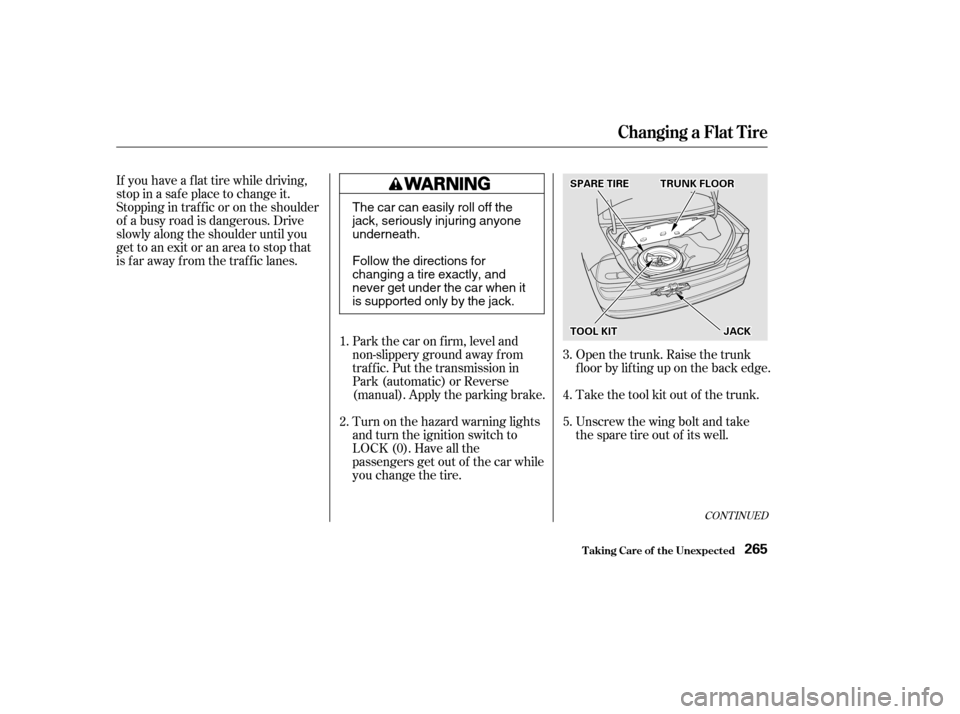Page 219 of 319
Check the f luid level with the engine
at normal operating temperature.Remove the dipstick (yellow loop)
f rom the transmission and wipe it
with a clean cloth.
Insert the dipstick all the way into
the transmission securely as
shown in the illustration.Remove the dipstick and check
the f luid level. It should be
between the upper and lower
marks.
Park the car on level ground. Shut
of f the engine. For accurate
results, wait at least 60 seconds,
andnomorethan90seconds,
af ter shutting of f the engine to
check the f luid level. 3. 4.
1. 2.
Automatic Transmission
T ransmission Fluid
Maint enance220
DDIIPPSSTTIICCKK
UUPPPPEERRMMAARRKKLLOOWWEERRMMAARRKK
UUPPPPEERRMMAARRKKLLOOWWEERRMMAARRKK
DDIIPPSSTTIICCKK((CCVVTT))
CCVVTT
Page 220 of 319
Insert the dipstick all the way back
into the transmission securely as
shown in the illustration.
The transmission should be drained
and ref illed with new f luid according
to the time and distance recommen-
dations in the maintenance schedule.
If the level is below the lower
mark, add f luid into the f iller hole
to bring it to the upper mark.
Always use Honda ATF-Z1
(Automatic Transmission Fluid). If
it is not available, you may use a
DEXRON
III automatic
transmission f luid as a temporary
replacement. However, continued
use can affect shift quality. Have
the transmission f lushed and
ref illed with Honda ATF-Z1 as
soon as it is convenient.
To thoroughly f lush the transmission,
the technician should drain and ref ill
it with Honda ATF-Z1 (Automatic
Transmission Fluid), then drive the
vehicle a short distance. Do this
three times. Then drain and ref ill the
transmission a f inal time.
5.
6.
T ransmission Fluid
Maint enance221
Page 253 of 319

Block the rear wheels.
Fill the f uel tank.
Change the engine oil and f ilter
(see page ).
Wash and dry the exterior
completely.
Cleantheinterior.Makesurethe
carpeting, floor mats, etc. are
completely dry.
Leave the parking brake off. Put
the transmission in Reverse
(5-speed manual) or Park
(automatic).
If you need to park your car f or an
extended period (more than one
month), there are several things you
should do to prepare it f or storage.
Proper preparation helps prevent
deterioration and makes it easier to
get your car back on the road. If
possible, store your car indoors.
If the car is to be stored for a
longer period, it should be
supported on jackstands so the
tires are of f the ground.
Leave one window open slightly (if
the car is being stored indoors).
Disconnect the battery.
Support the f ront wiper blade
arms with a f olded towel or rag so
they do not touch the windshield.
To minimize sticking, apply a
silicone spray lubricant to all door
and trunk seals. Also, apply a
vehiclebodywaxtothepainted
surfaces that mate with the door
and trunk seals.Coverthecarwitha‘‘breathable’’
cover, one made f rom a porous
material such as cotton.
Nonporous materials, such as
plastic sheeting, trap moisture,
which can damage the paint.
If possible, run the engine f or a
while periodically (pref erably once
amonth).
If you store your car f or 12 months
or longer, have your Honda dealer
perf orm the inspections called f or in
the 24 months maintenance schedule
(Normal Conditions) as soon as you
take it out of storage (see page ).
The replacements called f or in the
maintenance schedule are not
needed unless the car has actually
reached that time or mileage.
211
200
St oring Your Car
Maint enance254
Page 264 of 319

If you have a f lat tire while driving,
stop in a saf e place to change it.
Stopping in traf f ic or on the shoulder
of a busy road is dangerous. Drive
slowly along the shoulder until you
gettoanexitoranareatostopthat
is far away from the traffic lanes.Open the trunk. Raise the trunk
f loor by lif ting up on the back edge.
Take the tool kit out of the trunk.
Unscrew the wing bolt and take
the spare tire out of its well.
Park the car on f irm, level and
non-slippery ground away f rom
traffic. Put the transmission in
Park (automatic) or Reverse
(manual). Apply the parking brake.
Turn on the hazard warning lights
and turn the ignition switch to
LOCK (0). Have all the
passengers get out of the car while
you change the tire.
5.
4.
3.
2.
1.
CONT INUED
Changing a Flat T ire
T aking Care of t he Unexpect ed265
SSPPAARREETTIIRREETTRRUUNNKKFFLLOOOORR
TTOOOOLLKKIITTJJAACCKK
The car can easily roll off the
jack, seriously injuring anyoneunderneath.
Follow the directions for
changing a tire exactly, and
never get under the car when it
is supported only by the jack.
Page 270 of 319

Diagnosing why your engine won’t
start f alls into two areas, depending
on what you hear when you turn the
key to START (III):When you turn the ignition switch to
START (III), you do not hear the
normal noise of the engine trying to
start. You may hear a clicking sound
or series of clicks, or nothing at all.
Check these things:
You hear nothing, or almost
nothing. The engine’s starter
motor does not operate at all, or
operates very slowly.
You can hear the starter motor
operating normally, or the starter
motor sounds like it is spinning
f aster than normal, but the engine
does not start up and run. Check the transmission interlock.
If you have a manual transmission,
the clutch pedal must be pushed
all the way to the f loor or the
starter will not operate. With an
automatic transmission, it must be
in Park or Neutral.
Turn the ignition switch to ON (II).
Turn on the headlights and check
their brightness. If the headlights
are very dim or don’t light at all,
the battery is discharged. See
on page . Turn the ignition switch to START
(III). If the headlights do not dim,
check the condition of the f uses. If
the f uses are OK, there is proba-
bly something wrong with the
electrical circuit f or the ignition
switch or starter motor. You will
need a qualif ied technician to
determine the problem. (See
on page .)
If the headlights dim noticeably or
go out when you try to start the
engine, either the battery is dis-
charged or the connections are
corroded. Check the condition of
the battery and terminal connec-
tions (see page ). You can
then try jump starting the car from
a booster battery (see page ).
273 230
273289
Nothing Happens or the Starter
Motor Operates Very Slowly
Jump Starting Emergency T owing
If Your Engine Won’t Start
T aking Care of t he Unexpect ed271
Page 272 of 319

If your car’s battery has run down,
you may be able to start the engine
by using a booster battery. Although
this seems like a simple procedure,
you should take several precautions.
You cannot start a Honda with an
automatic transmission by pushing
or pulling it.To jump start your car, f ollow these
directions closely:
Open the hood and check the
physical condition of the battery
(see page ). In very cold
weather, check the condition of
the electrolyte. If it seems slushy
or like ice, do not try jump starting
until it thaws. Turn of f all the electrical acces-
sories: heater, A/C, stereo system,
lights, etc.
Put the transmission in Neutral or
Park, and set the parking brake.
1.
2.
230
CONT INUED
Jump Starting
T aking Care of t he Unexpect ed273
A battery can explode if you do
not follow the correct procedure,
seriously injuring anyonenearby.
Keep all sparks, open flames,
and smoking materials away
from the battery. If a battery sits in extreme cold, the
electrolyte inside can f reeze.
Attempting to jump start with a f rozen
battery can cause it to rupture.
Page 288 of 319

�µ
�µ �µ
The tow
truck uses two pivoting arms that go
under the tires (f ront or rear) and lif t
them of f the ground. The other two
tires remain on the ground.
If your car needs to be towed, call a
prof essional towing service or, if you
belong to one, an organization that
provides roadside assistance. Never
tow your car behind another vehicle
with just a rope or chain. It is very
dangerous.
There are three popular types of
prof essional towing equipment.
The operator
loads your car on the back of a truck. The tow
truck uses metal cables with hooks
on the ends. These hooks go around
parts of the f rame or suspension and
the cables lif t that end of the car of f
the ground. Your car’s suspension
and body can be seriously damaged.
If your Honda cannot be transported
by f lat-bed, it should be towed by
wheel-lif t equipment with the f ront
wheels of f the ground. If due to
damage, your car must be towed
with the f ront wheels on the ground,
do the f ollowing: Release the parking brake.
Start the engine.
ShifttoD,thentoN.
Turn of f the engine.
Release the parking brake.
Shif t the transmission to Neutral.
Automatic Transmission
5-speed Manual Transmission and
Continuously Variable Transmission(CVT)
CONT INUED
Wheel-lif t Equipment
Flat -bed Equipment Sling-t ype Equipment
T his is
an acceptable way to tow your
Honda.
This is the best way to transport
your Honda.
T his method of towing is
unacceptable.
Emergency T owing
T aking Care of t he Unexpect ed289
Improper towing preparation will
damage the transmission. Follow the
above procedure exactly. If you cannot
shif t the transmission or start the
engine (automatic transmission), your
car must be transported with the f ront
wheels of f the ground.
Page 293 of 319

�Î�Î�Î �Î �Î �Î
�Î �Î�Î�Î �Î �Î
�Î�Î
�Î
�Î �Î �Î�Î
Specif ications
T echnical Inf ormation294
Dimensions
Weights
Engine Capacities
174.7 in (4,438 mm)
66.7 in (1,695 mm)
55.1 in (1,399 mm)
103.1 in (2,620 mm)
57.9 in (1,470 mm)
57.9 in (1,470 mm)
2.95 x 3.72 in (75.0 x 94.4 mm) 13.2 US gal (50
, 11.0 Imp gal)
101.7 cu-in (1,668 cm
)
9.5 9.9
Length
Width
Height
Wheelbase
Track
Gross vehicle weight rating See the certification label attached
to the driver’s doorjamb.
Type
BorexStroke
Displacement
Compression ratio
Spark plugs Water cooled 4-stroke
SOHC , SOHC VTEC
4-cylinder gasoline engine
See spark plug maintenance
section page 225 .
Excluding the oil remaining in the engine.
Including the coolant in the reserve tank and that remaining in the
engine.
Reserve tank capacity: 0.108 US gal (0.41
, 0.090 Imp gal)
4.8 US qt (4.5
, 4.0 Imp qt)
2.6 US qt (2.5, 2.2 Imp qt)
6.0 US qt (5.7, 5.0 Imp qt)
6.3 US qt (6.0, 5.3 Imp qt)
3.3 US qt (3.1, 2.7 Imp qt)
2.9 US qt (2.7, 2.4 Imp qt)
1.7 US qt (1.6, 1.4 Imp qt)
1.6 US qt (1.5, 1.3 Imp qt)
4.4 US qt (4.2, 3.7 Imp qt)
3.5 US qt (3.3, 2.9 Imp qt)
3.2 US qt (3.0, 2.6 Imp qt)
3.7 US qt (3.5, 3.1 Imp qt)
3.4 US qt (3.2, 2.8 Imp qt)
Fuel tank
Engine
coolant
Engine oil Automatic
transmission
fluid 1.03 US gal (3.9
, 0.86 Imp gal)
1.00 US gal (3.8, 0.84 Imp gal)
1.00 US gal (3.8, 0.84 Imp gal)
1.32 US gal (5.0
, 1.10 Imp gal)
1.29 US gal (4.9, 1.08 Imp gal)
1.29 US gal (4.9, 1.08 Imp gal)
Front Rear Approx.
1: 2: U.S.: DX, LX
Canada: DX, LX
U.S.: HX, EX
Canada: Si
5:
1: 2: 3:4:
HX
DX, LX
EX, HX Change
ManualAutomaticCVT
Total ManualAutomaticCVT
Change
Without filter
Total
ChangeTotal
Change Total
U.S. Cars
Canada Cars
12
12 1 2
3 434 5 5
Manual trans-
mission fluidIncluding filter
Windshield
washer reservoir